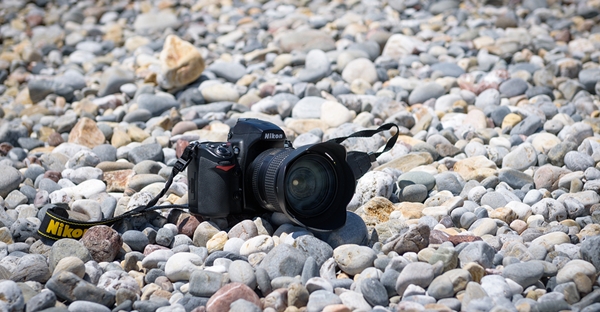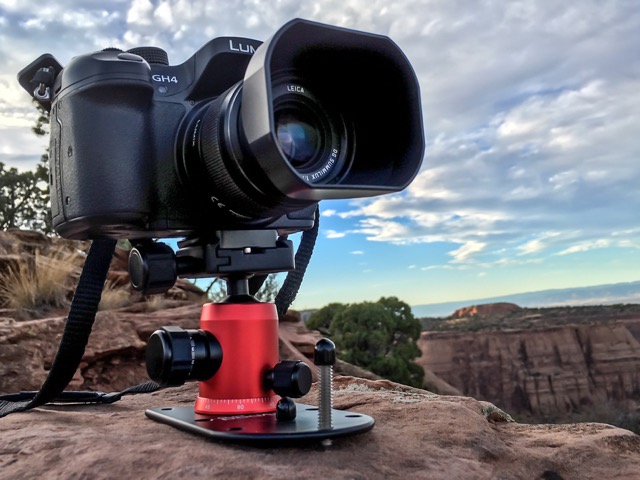This is one of the options I’ve been looking into lately. If I had already had this in my camera bag, I wouldn’t have missed those great camera angles this week.
The Platypod Pro isn’t the best choice for every photoshoot but it definitely gives you a lot more flexibility when you’re working in places where tripods aren’t allowed, or simply can’t be set up properly.
Have you used a Platypod or do you have one of your own? We’d love to hear your thoughts on it, so feel free to share in the comments below.
The Platypod Pro is basically a flat metal plate, with threaded holes for spiked feet and screw mounts for a ballhead or other accessories. If you get the Deluxe Kit, it also comes with a 1/4″to 3/8″ spigot adapter and a unique carrying pouch. What it does not come with is a ballhead, so that will need to be purchased separately if you don’t already have one to use. The interesting thing about the carrying pouch is that although it folds up flat to hold the plate and feet, it also expands into more of a box shape to hold a ballhead as well.
The base plate of the Platypod Pro is made of aircraft-grade aluminum, weighing in at a scant 3 ounces. It measures 3 inches wide by 5 inches long and is 4 millimeters thick. The carrying case that holds everything is approximately 1 inch thick and just slightly larger than the base plate. In other words, it is definitely small and light enough to slip into a camera bag or backpack.
Despite its small stature, it is claimed to hold up to 90 pounds of gear. Now, I don’t know about you, but all my cameras and gear put together don’t weigh 90 pounds. Of course, the actual weight capacity is going to depend more on the limit of the ballhead. My experience is that bulkier gear will exceed the base plate’s ability to hold it steady long before any weight limit is reached.
HOW DOES IT WORK?
The Platypod Pro is pretty easy to setup and use. Simply screw your ballhead onto the 3/8″ titanium bolt on the base plate and mount your camera. If the surface you are on is flat, you can just set the base flat and work from there. More uneven surfaces will require the use of the spiked feet, which are attached to the base plate in the 3 threaded holes. Approximately 1 inch of threads are available on each of the spiked feet, so that each one can be adjusted independently for height. As the name implies, one end of the spiked feet are pointed, which works well for digging into soft surfaces or grabbing onto rocks. The other end has a soft rubber cap to be used to grip smooth surfaces or provide protection on surfaces that you want to avoid scratching.
There are a number of photography accessories that could also be mounted on the Platypod Pro. Using the included spigot, you could attach a bracket to hold a speedlight, light modifier, or even a trigger.
In addition to the three threaded holes, there are four unthreaded holes on the base plate. These can be used to attach the base plate to a variety of surfaces and orientations using screws, nails, zip ties, or wire.
WHY YOU WOULD WANT ONE
One of the main uses for the Platypod Pro is to have a way to support your camera when a regular tripod is not practical. There are many places where tripods are not allowed, but the Platypod could serve as a substitute. I recently spent a few days wandering around New York City with some photography friends. Not only is a tripod frowned upon pretty much everywhere in the Big Apple, but I also was traveling light and wouldn’t have wanted to carry one anyway. The Platypod Pro was a welcome addition and didn’t take up much space in the backpack.
I can see the Platypod Pro accompanying me on many hikes into the mountains in the future. When going on long day-hikes or backpacking trips, traveling light is important and space is very limited. This device will be great to have along for times when hand-holding the camera is not an option.
Even in places where tripods are allowed, there are times that having a camera mounted low to the ground for a very low angle shot is desired. With the Platypod Pro, your camera can be set up just a few inches off the ground for these shots. Plus, because of its small footprint, it can be used it tight spaces.
Read the full review over at Improve Photography.
Source: Improve Photography
Image source: platypodpro.com


